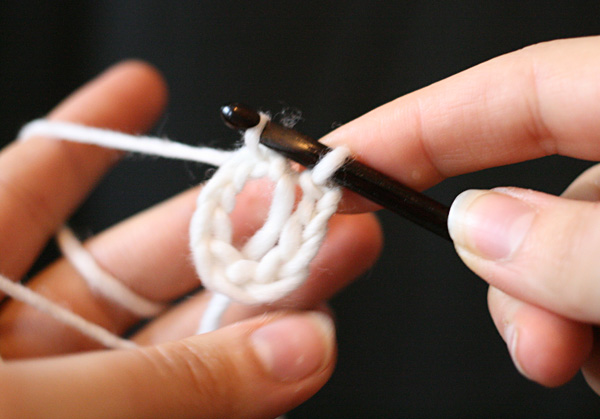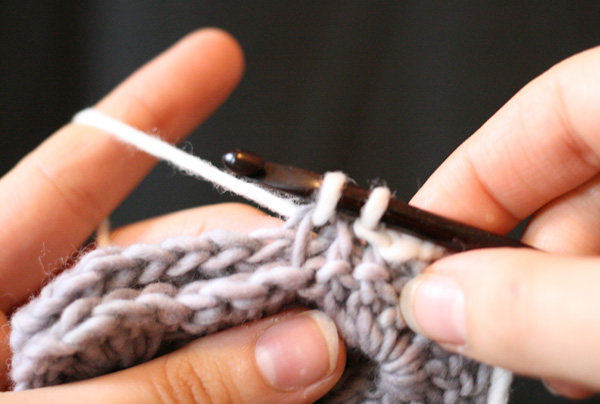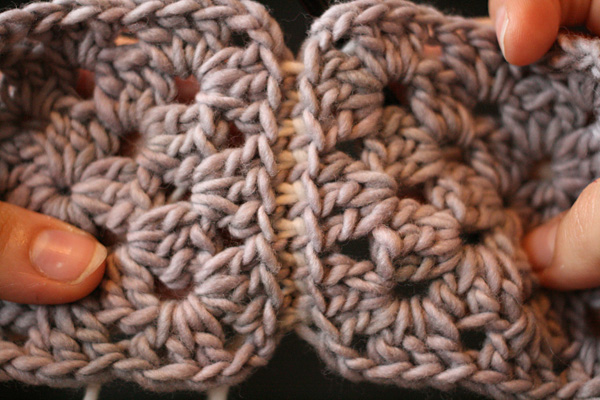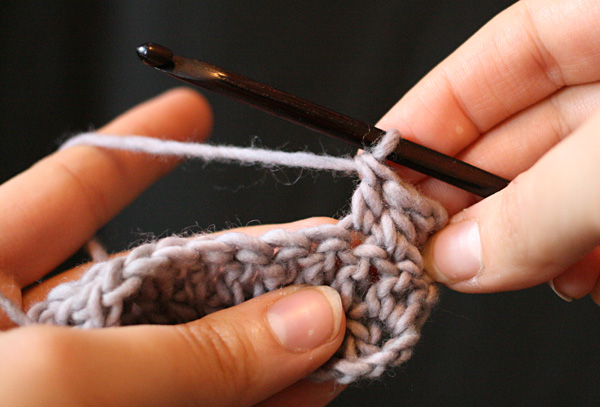Where is Granny When You Need Her?
  We were chatting with Knitty editors, Amy and Jillian, recently -- both new-ish crocheters, both feeling the zeal of the recently converted -- about what attracts them to crochet. Amy is passionate about granny triangles, and Jillian can't stop making granny squares (see photo at right). The granny motif is a draw because it is iconic and traditional -- it says "crochet." Grannies also have endless variation and are flexible building blocks of crochet construction. You can make one in a few minutes, and like little hexes in knitting or tiny quilt squares, they can be addictive. We were chatting with Knitty editors, Amy and Jillian, recently -- both new-ish crocheters, both feeling the zeal of the recently converted -- about what attracts them to crochet. Amy is passionate about granny triangles, and Jillian can't stop making granny squares (see photo at right). The granny motif is a draw because it is iconic and traditional -- it says "crochet." Grannies also have endless variation and are flexible building blocks of crochet construction. You can make one in a few minutes, and like little hexes in knitting or tiny quilt squares, they can be addictive.
We're going to work up to making a granny motif by learning the stitches required -- the chain and the double crochet. Next time, we'll work on crocheting in the round and creating and assembling small motifs. Then, we'll take our building blocks and create a wearable project using your newfound crochet prowess.
Back to Basics
If you are new to crochet, how you approach it and how you learn will depend on how you knit. Knitters who hold the yarn in their left hands and "pick" their stitches continental style (below left) may find the transition to crochet (below right) quite comfortable. Holding the yarn and crochet fabric is similar.

There are two common ways to hold the hook in crochet. We call one the pencil hold (below left), and one the knife hold (below right) because they mimic the way you would hold a pencil or a knife. But just like there is no wrong way to knit, there is also no wrong way to crochet or hold your hook. You need to play a bit and find what is comfortable for you. If you crochet a while and things don't feel right, try something different.

It's great, when you are jumping into a new skill to have buddies who can give you moral and physical support. Find crocheters at your local yarn shop and ask them to show you how they crochet.

The Chain Stitch
When we're teaching knitting, we often skip the cast-on for a brand new knitter and teach him or her the knit stitch first. The knit stitch is the most basic motion in knitting, and so we want our students to get that muscle memory ingrained as soon as possible. Crochet is a bit different. The gestures used in making the basic foundation of crochet, the chain, are the same ones you'll use for every stitch, so taking some time to make a long chain will serve you well. We often say, "chain until you just can't stand to chain anymore." You want your muscles to learn the motion. You won't use the miles of chain for anything -- unless you'd like to tie your hair or wrap some gifts with it -- so you can pull it out when you're done if you'd like. Or you can roll it into a ball and save it for something later.

Start with a slip knot, and make a yarnover with your working yarn.

Use the hooked end to pull the yarnover loop through the slip stitch.

Pull the new loop all the way through. Now you are ready to yarnover again.
In knitting (except combination knitting), a yarnover is made from front to back so it's oriented in the same way as the other stitches, but with crochet a yarnover is formed by placing the working yarn over the hook from back to front (or to shorten the movement swooping the hook under the working yarn and up, which will catch the working yarn in the same way).
Crochet abbreviations
Slip stitch: sl st
Chain: ch
Chain Space: ch sp
Double Crochet: dc |
Use That Chain in Your Knitting
Now that you know how to make a crocheted chain you already have something in your tool-kit that you can incorporate into your knitting. Crochet chains are one helpful way to create a provisional cast-on. Stitches are knit into the chain, and later, when the chain is unraveled, you're left with live stitches you can knit in the opposite direction. Chain stitches combined with slip stitches (below) can be another way to join pieces of knitting together.
Slip Stitch
The slip stitch (abbreviated as sl st) is the shortest of crochet stitches, and it's not a very common way to create crochet fabric. It's like working the chain stitch, but through a stitch or space in your knitting or crochet. It's most often used to join pieces of fabric together, or to move the starting point of your crochet from one point in your work to another without adding another row. A slip stitch can add rigidity to your work, so it is sometimes used as an edging. If you're using a slip stitch to join, you'll want to take care to work it loosely enough that the seam does not become the point of least elasticity in your project.
To work the slip stitch:
Insert the hook into the next stitch or space, yo, pull the hook back through the fabric and through the first loop on your hook.




Slip stitch on the edge of a swatch



Slip stitch to join a chain




Slip stitch to join two pieces of crocheted fabric
Use Slip Stitches in Your Knitting
You can use your crochet hook to seam pieces of knitting together using slip stitches. You might also use it if you need a firm edging somewhere on your project, but you don't want to add any length. An opening, like a pocket, or the opening for a bag might be a good place for slip stitches because the rigidity would help keep the space open. 




Slip stitch to join two pieces of knitted fabric
Double Crochet
To work a Double Crochet (abbreviated in pattern writing as dc): yo, insert the hook in the space or stitch indicated, yo, pull a loop back through (you'll now have 3 loops on your hook), yo, pull the hook through the first two loops on the hook, yo, pull the hook through the remaining loops.






Double Crochet is the main building block of the Shell stitches that make up a granny square. A shell is any multiple of stitches worked into the same stitch or space.
Using Double Crochet in Your Knitting
Double crochet and the shells that you can create with it make pretty edgings for crochet; by combining shells with skipped spaces along the edge of a project or garment, you can create a scalloped edge.
Where does your hook go?
In knitting, where to put the needle next is a relatively simple question. You're more than likely going to be taking your right needle and inserting it into a loop or loops on your left needle.
Crochet is fundamentally different. Each stitch is complete (bound off, to use a knitting metaphor) and doesn't live on the hook once you've created it. Crochet stitches are not "live" the way knitting stitches are, and therefore you don't need a live stitch to build more stitches. You can feasibly create new crochet stitches anywhere you can get a hook through fabric. It's a concept that's both liberating and complicating. "Yes! I can make stitches anywhere! That means my crochet can take any shape I want," leads quickly to, "Oh no! My crochet is not staying in the lines, how do I create a simple rectangle?" (Or any shape a pattern requires.) Today we're going to consider placing the hook when working in double crochet in rows. Later, we'll talk about how things might be different working in rounds.
In rows, you have three areas to consider: the start, the body of the row, and the end. Because the hook can go anywhere, and might go in different places depending on the pattern, it's important to pay attention to pattern language. For instance, A pattern might begin:
Row 1: Ch 23, dc in 4th ch from hook, dc in each ch to the end of the row. Turn.
Following these instructions, you'd end up with 20 stitches in your next row: 19 double crochets and 1 turning chain created by the three chains you didn't work at the beginning of the row.



Continuing in the swatch above, the next row could read:
Row 2: Ch 3, skip first dc, dc in each stitch across. Turn.



Following the instructions would maintain the count of 20. What the pattern is not explicit about is what to do with that turning chain you made in the row below. Typically, the final double crochet is worked into the top (meaning the ch closest to the previous stitch) of the turning chain.

Why do the instructions say "skip first dc?" That's because in a row of double crochet, that turning chain acts as the first double crochet of the row.

Stitches Out of Thin Air
In many crochet patterns, instead of working into other stitches, instead of working into other stitches, we make new crochet stitches in the chain spaces (abbreviated as ch sp) between stitches.
In the swatch you started above, try this:
Row 3: Ch 5, skip first three stitches, *(dc in each of the next two stiches, ch 2, skip 2 sts), repeat from * to the end of the row, dc in turning ch from the row below.

In the row above, you've created five chain spaces where stitches can go in the following row.
Row 4: Ch 3, *(2 dc in the next ch sp, ch 2), repeat from * to last ch sp, 2 dc in final ch sp, dc in turning ch.

Repeating Rows 3 and 4 gives you an alternating pattern of ch spaces that resembles the granny square motif. Granny squares use the same idea of a chain space but they are worked in the round. We'll try one next time.
| 



